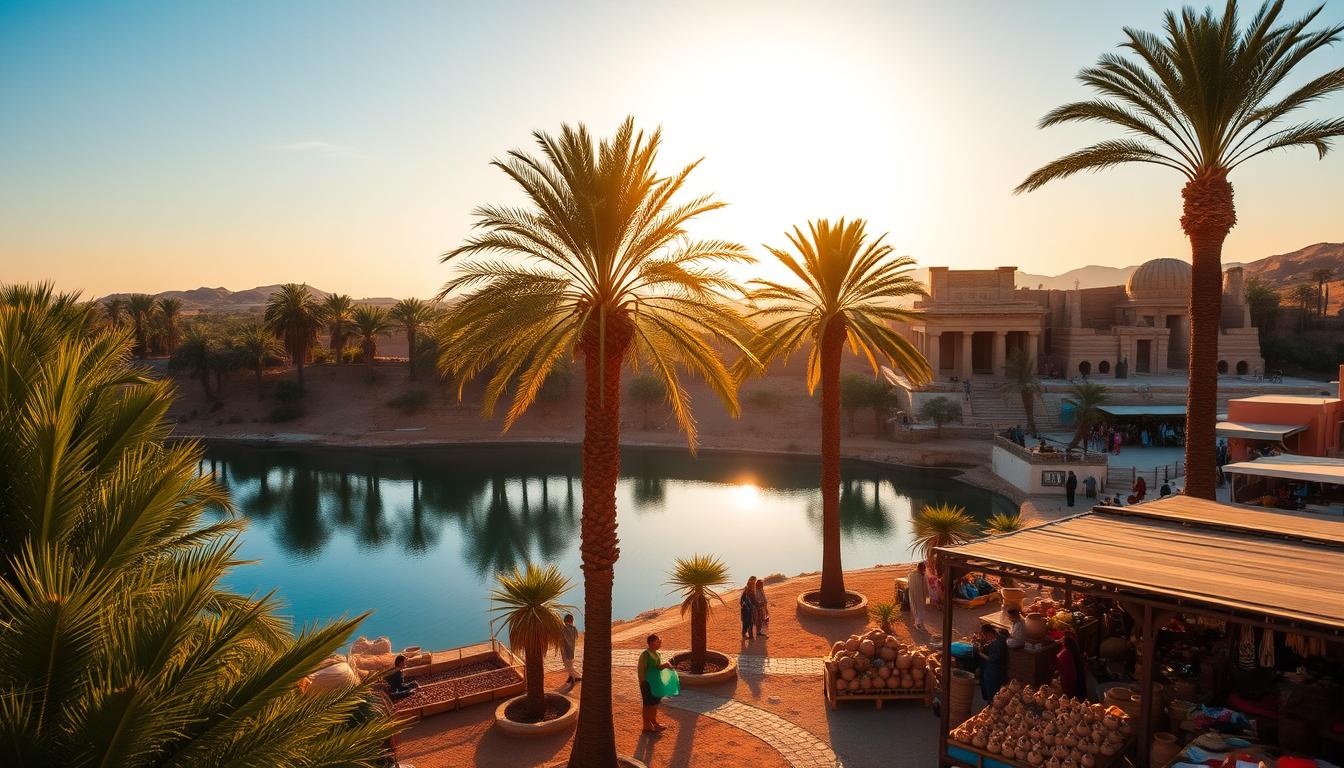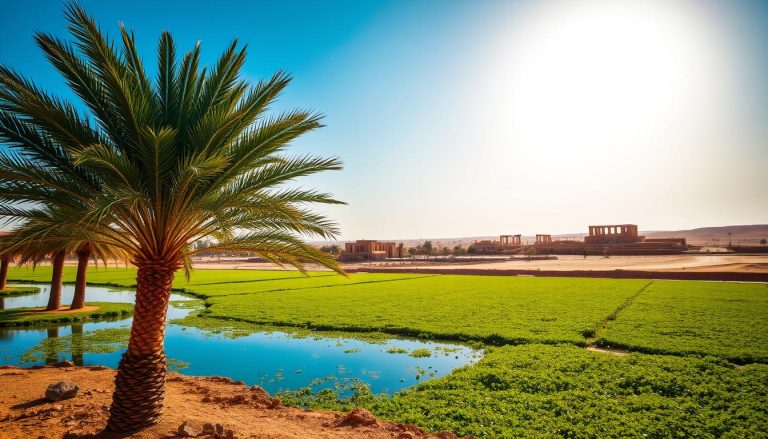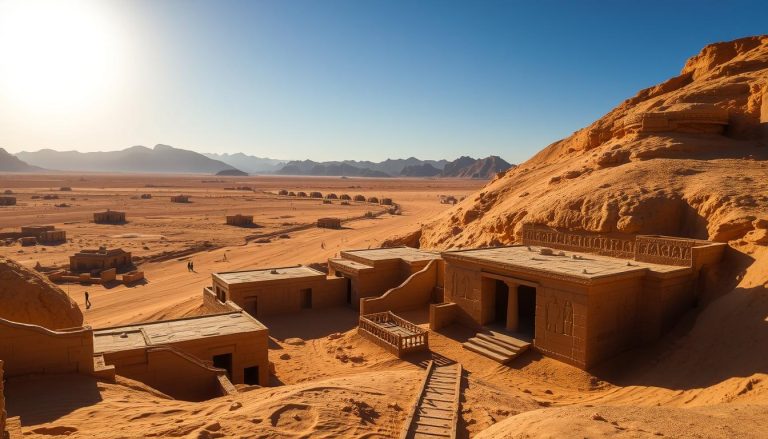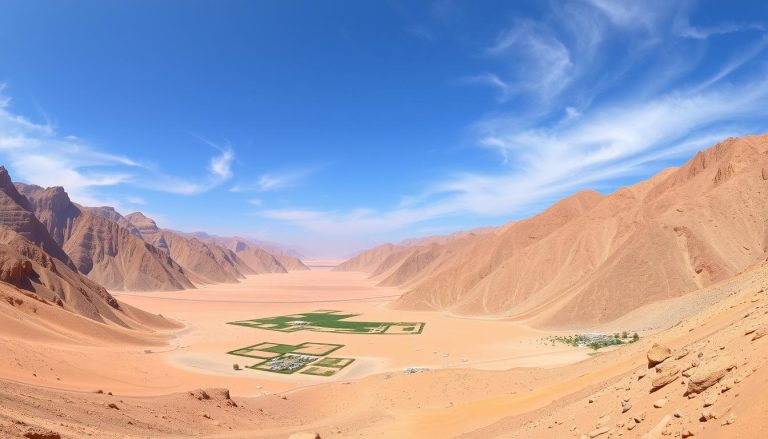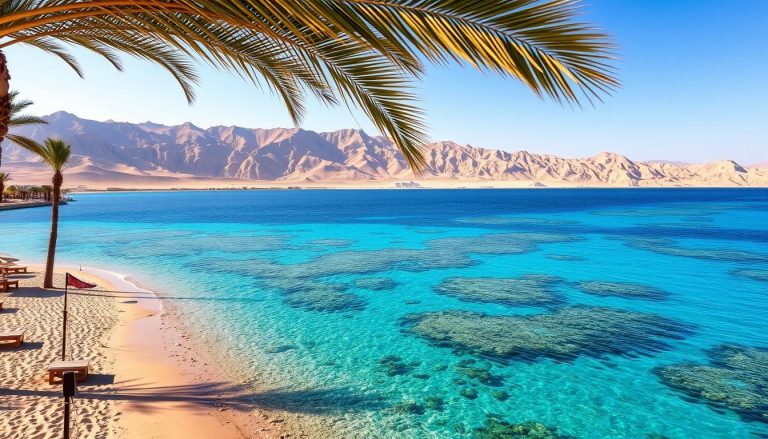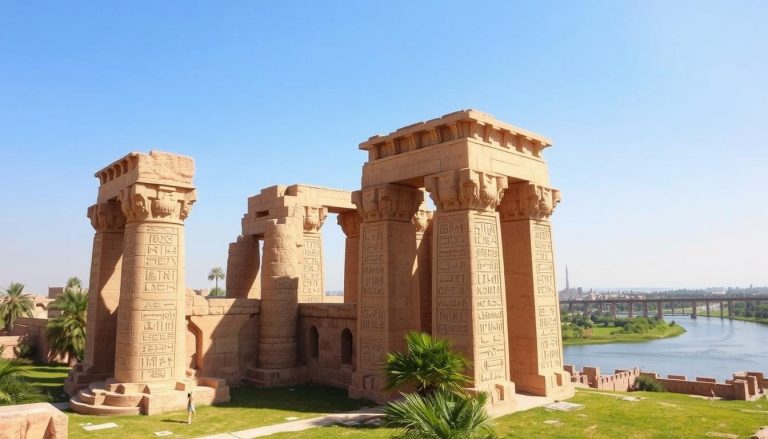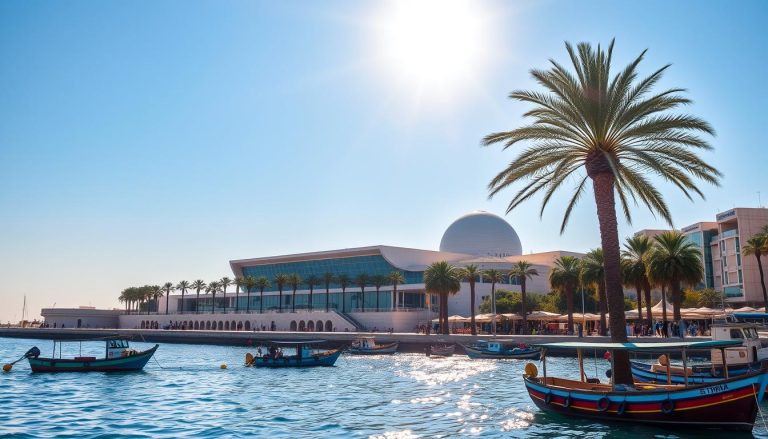Ever wondered about hidden gems beyond Cairo’s busy streets? Look no further than Faiyum, an ancient oasis. It’s a place that will amaze you with its history and natural beauty. Faiyum is a top spot for anyone wanting to explore Egypt’s rich past and culture.
Key Takeaways
- Faiyum, located 100 km south of Cairo, is one of Egypt’s oldest cities with moderate weather year-round.
- The city offers a diverse range of attractions from various eras including Pharaonic, Greco-Roman, Coptic, and Islamic.
- Key attractions in Faiyum include Wadi El Rayan, Lake Qarun, Wadi El-Hitan, ancient pyramids, waterwheels, and the Tunis Village art hub.
- Faiyum’s natural wonders and cultural heritage make it a must-visit destination for those seeking to explore the rich history and beauty of Egypt.
- With its moderate climate and array of activities, Faiyum is a perfect getaway for those looking to escape the hustle and bustle of Cairo.
Discovering the Ancient Oasis: Location and History of Faiyum
The Faiyum oasis is in Egypt’s heart, with a history that goes back to ancient times. It was once called “Shedet” in the Old Kingdom and “Ta-She” in the Middle Kingdom. The name Faiyum comes from the Coptic “Pa-Ym”. This area, with Lake Qarun, is fed by the Nile branch Bahr Youssef. It’s a key spot for farming and culture in Egypt’s past.
The Evolution from Shedet to Modern Faiyum
The Faiyum region has a rich history, from ancient times to today. Shedet, its first name, was a place of worship for Sobek, the crocodile god. In the Middle Kingdom, it was called “Ta-She”, meaning “the lake”. This shows how important water was there.
Later, the name changed to Faiyum, showing its Coptic roots. Now, Faiyum is split into six areas, covering 4,678 square kilometers. Of this, 1,437 square kilometers are farmland.
Climate and Geography of the Region
Faiyum has a hot, dry climate with little rain in winter. It’s a big depression with Lake Qarun at the bottom. The Nile’s water makes it a fertile and cultural center in ancient Egypt.
Cultural Significance Through the Ages
Faiyum has been important for thousands of years. It has ancient temples and pyramids, and now busy towns and villages. Visitors can explore its rich history and lively culture in the Faiyum oasis.
Wadi El Hitan: Valley of the Whales UNESCO Site
Wadi El Hitan is a UNESCO World Heritage Site 150 miles southwest of Cairo. It takes visitors back in time to see whales’ ancient evolution. This natural wonder is famous for its 40-million-year-old whale fossils.
These fossils show how whales changed from land animals to sea giants. The site’s most famous fossils are Basilosaurus and Dorudon. They still had hind limbs, showing their slow move to the sea.
The Wadi Al Hitan Fossil and Climate Change Museum opened in 2016. It explores whales’ evolution and the area’s environmental changes over time. The museum showcases these incredible fossils.
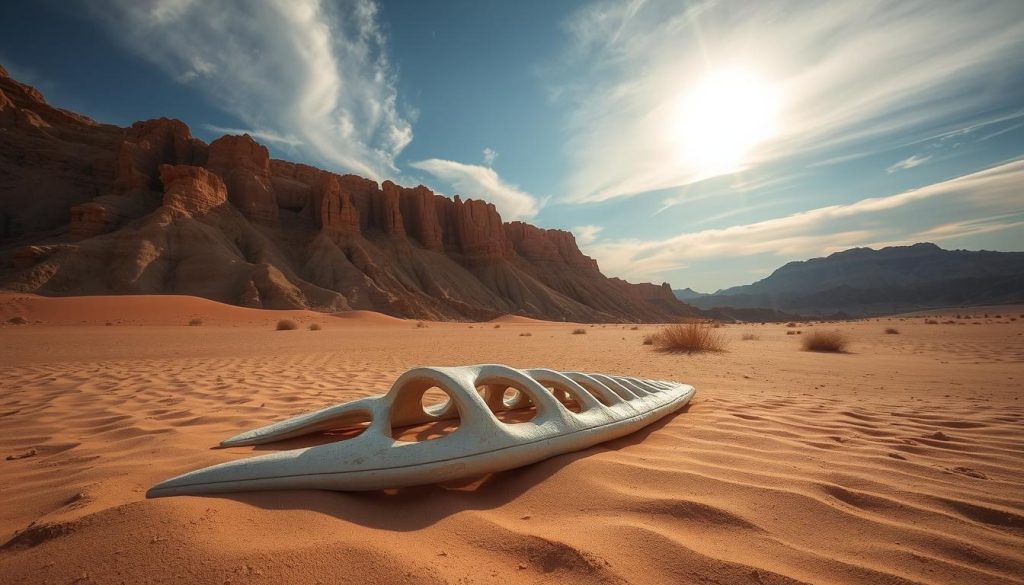
Wadi El Hitan gets about 1,000 visitors a year. They come for its paleontological importance and natural beauty. Getting there requires 4WD vehicles, making the journey exciting.
Visiting Wadi El Hitan is a chance to see the ancient past. It’s a journey into whales’ evolution. This UNESCO site is a treasure that shows the wonders of our planet.
Lake Qarun National Park: Wildlife and Activities
Lake Qarun is a natural wonder in the Faiyum Oasis. It covers 1,155 square kilometers. It’s known worldwide as an “Important Bird Area” and a top spot for bird watching.
Whether you love birds or just enjoy nature, you’ll be amazed by the lake’s birdlife.
Bird Watching Opportunities
Lake Qarun is home to many bird species. The best time to see them is during winter. Thousands of birds, like flamingos and pelicans, visit the lake.
Bring your binoculars and camera. You’ll see the amazing variety of birds here.
Water Sports and Fishing
Lake Qarun is great for more than just bird watching. You can enjoy boating, kayaking, and swimming here. Fishing is also popular, with many fish species to catch.
Best Times to Visit
The best time to visit Lake Qarun depends on what you like. For bird watching, winter months are best. For water sports and fishing, visit in warmer months.
“Lake Qarun is a true oasis of tranquility, where the beauty of nature and the thrill of adventure come together in perfect harmony.”
The Historic Waterwheels of Faiyum
In the heart of Egypt’s Faiyum Oasis, over 200 ancient waterwheels stand. These irrigation systems date back to the Greco-Roman era. They show the cleverness of the people who lived there.
Made from strong white wood called ‘Azizy’, these waterwheels keep Faiyum’s lands green. The biggest one is in Basiouniya village. It waters 37 hectares of land.
Every year in mid-January, the community fixes these waterwheels. They replace them every six years, celebrating with parties. The seven black waterwheels are symbols of Faiyum’s history and farming skills.
These Faiyum waterwheels show the area’s clever irrigation system. When you visit Faiyum Oasis, see these historic wonders. They show the area’s lasting spirit and strength.
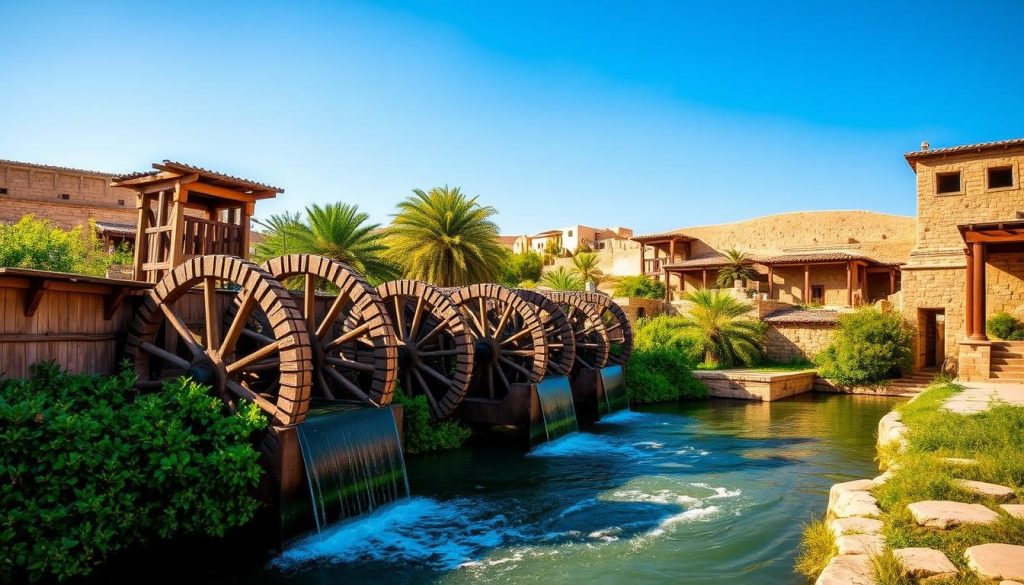
“The waterwheels of Faiyum are not just a sight to behold, but a testament to the enduring spirit of this remarkable region.”
Ancient Pyramids of Faiyum: Hawara and Lahun
In the heart of the Faiyum oasis, the ancient Pyramids of Hawara and Lahun stand. They show the skill of ancient Egypt’s builders. These structures give us a peek into the region’s rich history and culture.
Architectural Features and History
The Hawara Pyramid was built by Amenemhet III of the 12th Dynasty. It’s just 9 kilometers from Faiyum. It has a unique southern entrance and was once covered in white limestone.
The Lahun Pyramid was built by Sensret II about 4,000 years ago. It also has a southern entrance. This gives us a look into ancient Egyptian building and burial practices.
Both pyramids show the creativity and skill of their builders. They fit perfectly into the landscape. These monuments prove the lasting impact of ancient Egyptian architecture.
Visiting Tips and Access Information
The Hawara Pyramid is closed to visitors inside. But the Lahun Pyramid was restored and opened in June 2019. Now, people can see its architectural beauty up close.
Visitors can easily add these sites to their Faiyum trip. They’re just a short drive from the city. Whether you love history, architecture, or just the past, these pyramids are a must-see.
Wadi El Rayan Waterfall and Magic Lake
In Egypt’s Faiyum region, Wadi El Rayan is a hidden gem. It covers over 1,759 square kilometers. Here, you’ll find Egypt’s only waterfall, attracting many visitors.
Explore the upper and lower lakes and the El Rayan Springs. Don’t miss the El Rayan Falls. You might see gazelles, foxes, and many birds.
The Magic Lake in Wadi El-Hitan is a must-see. It changes colors with the day, creating a stunning view. Enjoy the calm, swim, or try sandboarding down the dunes.
| Tour Details | Highlights |
|---|---|
|
|
Wadi El Rayan and Magic Lake offer peace or adventure. They are unforgettable. Visit this oasis and see Faiyum’s natural attractions for yourself.
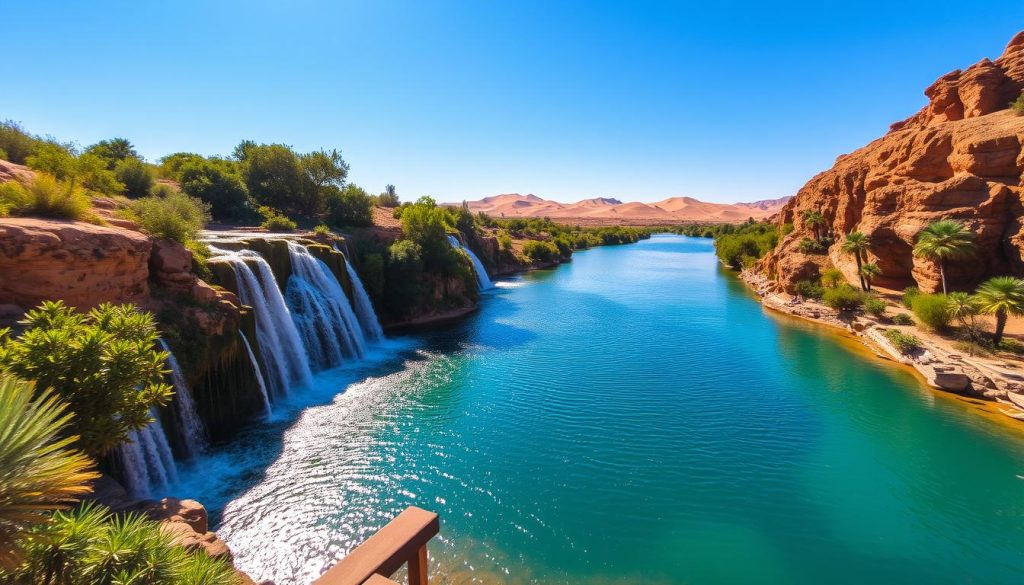
Tunis Village: Art and Culture Hub
Nestled in the heart of Fayoum, Tunis Village is a vibrant hub of art, culture, and traditional craftsmanship. It was founded in 1962 by an Egyptian author and his Swiss spouse. This picturesque village is a beacon for reviving the local pottery industry and promoting eco-tourism in the region.
Pottery Workshops and Local Crafts
Tunis Village is famous for its pottery workshops. Skilled artisans show their mastery of the craft here. Visitors can see the process of creating glazed pottery and watch potters shape clay into beautiful pieces.
There’s more than pottery here. The village also offers local handicrafts like palm products, embroidery, carpets, and kilims. Exploring these workshops and boutiques gives a real look into the artistic traditions passed down through generations.
Cultural Experience and Shopping
Walking through Tunis Village’s winding streets feels like stepping back in time. The quaint buildings, with vibrant murals and intricate details, create a captivating atmosphere. Visitors can dive into the local culture by joining workshops, watching artisans work, and checking out the handcrafted Egyptian crafts.
Whether you’re looking for a unique pottery piece or just want to enjoy the vibe, Tunis Village offers a special cultural experience.
“Tunis Village is a testament to the enduring spirit of Fayoum’s artisans, showcasing the region’s rich cultural heritage through their exceptional Tunis Village crafts.”
Natural Wonders: Petrified Forest and Mudawara Mountain
Fayoum, Egypt, is a treasure trove for nature lovers. It has many geological sites that show its rich history. The Petrified Forest and Mudawara Mountain are top spots to see.
The Petrified Forest is 30 km from Cairo. It’s 35 million years old and covers 7 square kilometers. It was made a protectorate in 1989. Here, ancient trees from the Red Sea hills are preserved.
Visitors can explore this fossil forest. They can see 40-meter-high petrified tree trunks. These trees have stood for millennia.
Mudawara Mountain is west of Lake Qarun. It offers a stunning view of Fayoum. The mountain has three peaks and is easy to climb.
Its geological formations give insight into Fayoum’s past. It’s a key spot for those interested in Petrified Forest, Mudawara Mountain, and geological sites.
“The Petrified Forest of Fayoum is a remarkable natural wonder. It shows the power of nature and time. Exploring it is like going back in time, a humbling and awe-inspiring experience.”
| Attraction | Key Facts |
|---|---|
| Petrified Forest |
|
| Mudawara Mountain |
|
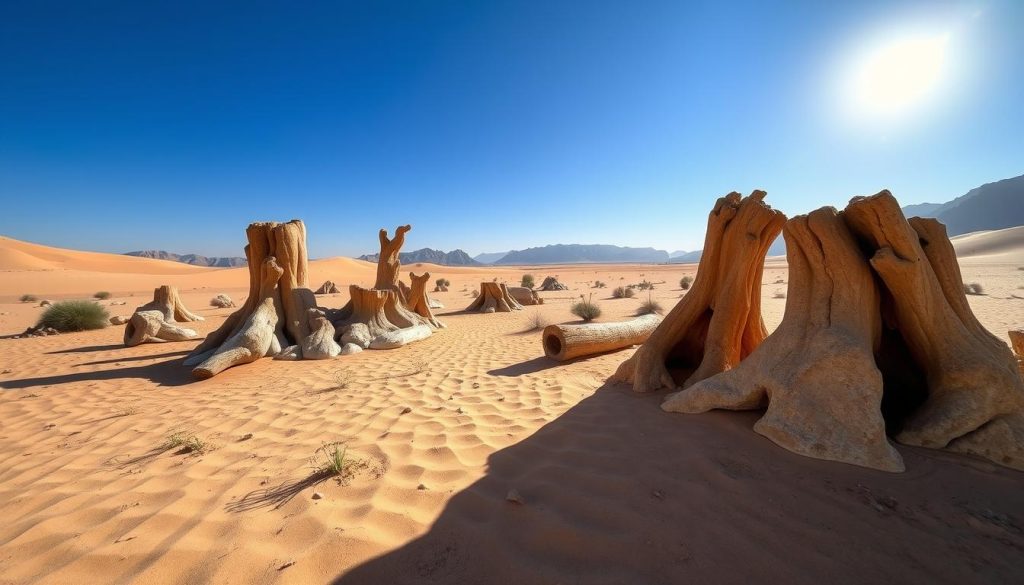
Fayoum’s Petrified Forest and Mudawara Mountain are amazing natural wonders. They give visitors a chance to see the geological history of this area. Whether you’re an experienced explorer or just curious, these sites will impress you and deepen your understanding of Earth’s past.
Faiyum, Egypt: Best Things to Do - Top Picks
Faiyum, an ancient oasis in Egypt, has something for everyone. It boasts natural wonders and historic sites. This place offers a deep dive into Egypt’s rich history and culture.
The UNESCO World Heritage Site of Wadi El Hitan is a must-see. It’s known as the “Valley of the Whales.” Here, you can see fossils of ancient whales. It’s a window into the past, showing how whales evolved over millions of years.
Don’t miss the Pyramids of Hawara and Lahun. They are architectural wonders with a rich history. These pyramids, from the 12th Dynasty, tell stories of ancient Egypt.
The waterwheels in Faiyum are another highlight. They show the region’s clever water management systems. These large, impressive structures are a testament to Faiyum’s ancient ingenuity.
Nature lovers will enjoy Lake Qarun National Park. It’s great for bird watching and water sports like fishing and boating. The park’s beauty is matched by its diverse wildlife and plants.
Explore more of Faiyum’s natural wonders. The Wadi El Rayan Waterfall and Magic Lake are breathtaking. Nearby, the Petrified Forest and Mudawara Mountain reveal Faiyum’s geological past with their fossils and unique rocks.
Visit Tunis Village to experience Faiyum’s culture. Here, you can see local art and crafts. Pottery workshops and markets await, offering a chance to connect with the community.
Faiyum is a treasure trove of history, culture, and nature. It’s a top spot for anyone wanting to explore Egypt’s wonders. Discover its secrets and make unforgettable memories in Faiyum.
Conclusion
Exploring Faiyum, Egypt, reveals a mix of natural beauty, history, and culture. You’ll see ancient pyramids, fossilized whales, and vibrant art scenes. The region’s landscapes are stunning, showing Egypt’s heritage and natural wonders.
Faiyum has something for everyone, from archaeology to adventure. It’s a place where ancient history meets untouched nature. This makes it a top spot for those wanting to see Egypt’s less-known sides.
As you delve into the Faiyum travel guide, you’ll find experiences that excite your senses. Egypt’s tourism is rich and diverse. Faiyum promises a deeper understanding of Egypt’s legacy, making you want to come back.
